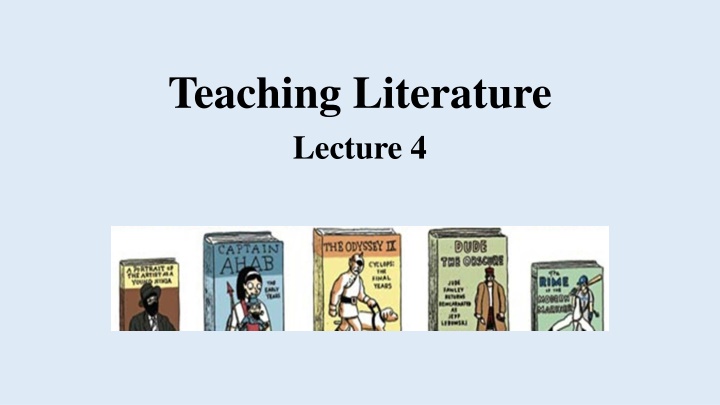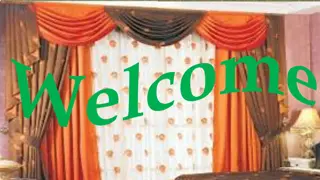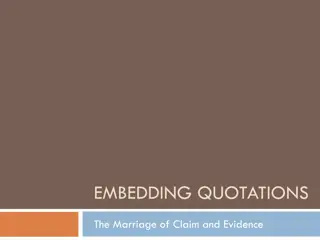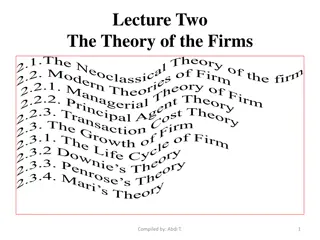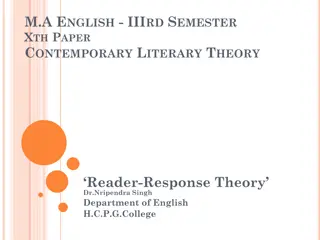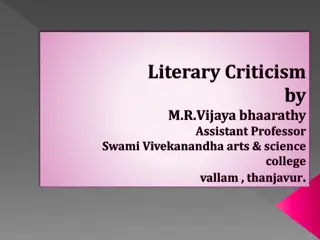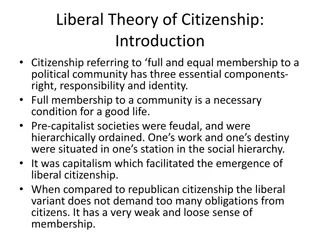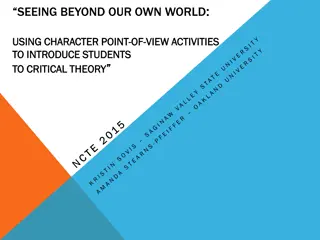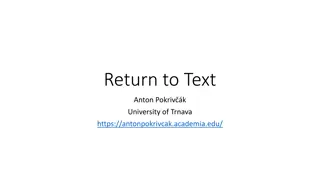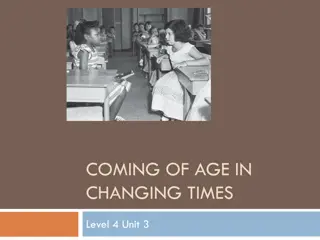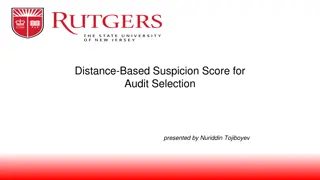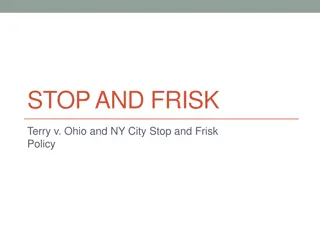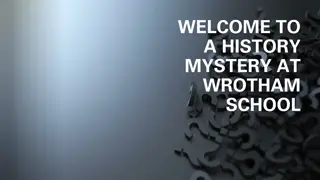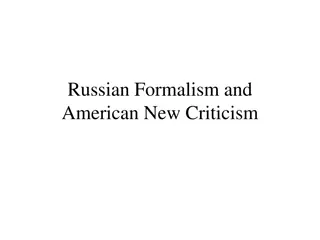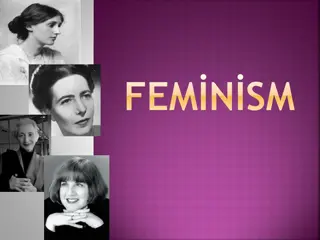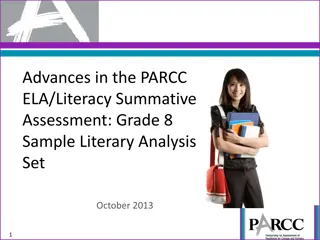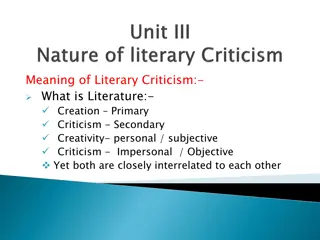Evolution of Literary Theory and Analysis: From Suspicion to Significance
Literary theory and analysis have evolved significantly over the past few decades, transitioning from suspicion and skepticism to becoming essential tools in understanding literature. The traditional emphasis on just reading the words on the page has been replaced by a deeper exploration of various themes such as semantics, gender, politics, and ethnicity. This evolution is a testament to the importance and impact of theory in the study of literature, reflecting a shift towards more nuanced and critical approaches.
Download Presentation

Please find below an Image/Link to download the presentation.
The content on the website is provided AS IS for your information and personal use only. It may not be sold, licensed, or shared on other websites without obtaining consent from the author.If you encounter any issues during the download, it is possible that the publisher has removed the file from their server.
You are allowed to download the files provided on this website for personal or commercial use, subject to the condition that they are used lawfully. All files are the property of their respective owners.
The content on the website is provided AS IS for your information and personal use only. It may not be sold, licensed, or shared on other websites without obtaining consent from the author.
E N D
Presentation Transcript
Teaching Literature Lecture 4
Teaching Literary Theory and Teaching Writing POSITIONING LITERARY THEORY As the value of theory stock began to rise dramatically about thirty years ago in a bull market that still persists many teachers of literature back then (and some still today) were highly suspicious of it in the classroom. Occasionally, the more excitable among them were given to pounding the table like Dickensian characters, asserting loudly (thump thump) that they weren t going to stand for any of this blasted theory nonsense in their literature classes, where they performed the time-honoured, probably divinely appointed job of teaching students just to read the words on the page .
Positioning literary theory (contd.) We ve come a long way since then. No one believes in innocent readings any more, or theory-free readings either. And no one thinks any longer that just the words on the page are transparent with regard to anything, whether semantics, gender, politics, ethnicity or any other issue that might (or might not) be explicitly referred to in any particular work of literature under interrogation a courtroom or jail house metaphor contemporary approaches to literary analysis. Given the long history of literature and the extremely recent moment of theory s ascendancy, it is astonishing that theory could have become so important in such a short time. that says volumes about
Positioning literary theory (contd.) History of literary study Academic study of literature has its roots in four intellectual and academic traditions philology, classics, rhetoric, belles- lettres and owes many of its analytical techniques to these traditions. 1. Philology 2. Classics 3. Rhetoric 4. Belles-lettres
1. Philology From philology, literary study inherited highly developed techniques for concentrating powerfully on all the possible meanings and significance of individual words. Philology as a discipline provided the model of a methodology for interpreting individual words at three important levels: their semantic territory, their etymological history, and the semantic layers made up by their etymological history. Philology also taught literary study how to fit the word, with all its unpacked baggage, back into the context of the passage from which it came.
2. Classics Classics provided literary study with two things, literary works to be studied (a curriculum for Literature) and the model of a pedagogy for teaching literature. It was a pedagogy of professorial lecture combined with student recitation, that is each student in turn translating a given passage. In classics classes the translation was literal (Greek and Latin words rendered into English words); in later literature classes taught in the vernacular the translation became interpretation , but often of a literal sort based on word-by-word paraphrasing ( What Milton is saying in these lines is . . . ) to establish to the teacher s satisfaction that the student got the meaning of the passage.
3. Rhetoric Rhetoric, the ancient discipline of the arts of persuasion, provided literary study with a large number of concepts, analytical categories and methodological strategies that were easily transferred from the analysis of speeches to the analysis of literary works. Rhetoric has a 2,500 year history during which it has developed ways of analysing the ethos the characteristic spirit and beliefs of speakers (easily transferred to the analysis of literary narrators and even the analysis of literary authors); analysing the speakers ethical, emotional and intellectual effects (easily transferred to a concern for a literary work s effects on readers); and analysing a vast array of figures of speech (which required no transfer techniques at all but could be incorporated in their entirety into literary analysis).
4. Belles-lettres Finally, the tradition of belles-lettres included not only literary works that were treasured and studied but also the fine writing about these treasured texts produced by well- educated readers, whose own refinements of sensibility and literary talent often rivalled the sensibility and talent of the writers in whose praise they wrote.
Belles-lettres (contd.) Belles-lettristic writing about literature developed the model of a thoughtful person sitting down with a literary work of life-long acquaintance and writing his or her reactions to that work, often in an impressionistic way but also in a way informed by additional reading that was both wide and deep, intelligence that was flexible and far ranging, thoughtfulness that tended to concentrate on moral issues central to the universal task of making a life, and an analytical sensibility that was not professional in orientation but nevertheless powerfully attentive to literary details, nuances, tones and linguistic suggestiveness of all sorts.
Belles-lettres (contd.) Horace, Cicero, Petrarch, Philip Sidney, Dryden, Samuel Johnson, Montaigne, William Matthew Arnold, Virginia Woolf, F. R. Leavis, Edmund Wilson, C. S. Lewis, Lionel Trilling these are some of the writers who in the belles-lettristic tradition helped develop the model of a particular kind of literary responsiveness that became an important strand in the intellectual, professional and historical development of the discipline of English Literature. Hazlitt, Charles Lamb,
When these four models of linguistic and literary study were pulled together to form the intellectual foundation for the first departments of English Literature near the end of the nineteenth century, it was to be expected (and was, indeed, the case) that the departments at first found their interests and their methodologies deeply tinctured by the intellectual roots from which they drew. However, the very fact that the departments were founded as academic enclaves unto themselves meant that inevitably the study of literature would begin to professionalise, subdivide and specialise itself on the model of the other academic disciplines for which subdivision, specialisation and professionalization had already proved a spectacular means of both making and measuring intellectual progress. These were also ways of making careers; it became incumbent on academics to make themselves successful because literary study in the modern research university became a way of making a living, not just a habit or a manner of living.
Specialisation The importance of literary theory today is in large part the consequence of a straight path of development along lines of specialisation, subdivision and professionalisation that began nearly a hundred years ago. What specialisation and professionalisation had already accomplished in the Sciences and other academic disciplines they have also accomplished in the discipline of Literature. In short, when progress is defined as that which advances the intellectual professionalisation of the discipline.
Specialisation (contd.) Theory, then, is a way of specialising the study of literature such that only professionals can do it (in the sense of making a career of it). It is also the case that certain large historical and political developments liberated literary study from its historical roots and not only hastened its professionalisation but made that professionalization easier to accomplish and, moreover, imparted to contemporary criticism some of its special attitudes and concerns.
Approaching the Teaching Academic Writing Although the types of assignment that are set in Literature courses are now quite varied, writing is still the main focus. This not only reflects the situation of the academy generally, based as it is on the written mode as the means of codifying knowledge (enabling analysis of and reflection on it) and of dissemination, but also the situation of Literature and other text-based disciplines and fields in particular (e.g. History, Philosophy, Sociology, European Studies . . .) in which the essay is still the favoured form of writing.
The Essay Above all, the essay form allows students the space to construct an argument. That is, an argument that expresses interpretative points of view, using the appropriate theoretical and analytical concepts and terms and space to illustrate that argument and offer evidence in support of it. When the teacher marks and comments on the essay, that argument forms the basis of a dialogue between teacher and student.
Essay writing, then, is a main way in which students learn Literature, not just a way of demonstrating their knowledge and skill and having them graded; as Taylor et al. put it (1988), writing demands the creation of meaning and the expression of understanding (p. 2). It follows from this that teaching students to write about literary texts and topics is teaching them Literature which, in turn, seems to suggest that it is an important part of the Literature teacher s job to teach students to write. One objection, however, might be that there are aspects of essay writing that are generic and can be taught by others than literature teachers as indeed is the case in many universities world-wide, where academic support units offer all students a drop-in service and/or a dedicated website, and may also offer courses on writing as well as study skills more widely.
In this context, the focus is normally on the conventions of the academic way of writing as an identifiable and distinct form. While in such courses worked examples of writing may be taken from a range of disciplines and fields (though rarely from Literature it seems), these examples are most often used to illustrate general features of academic writing such as voice, objectivity, structuring, referencing, etc. This kind of teaching may be very helpful to students who have little or no knowledge of the academy and we certainly do not mean to denigrate it, but arguably it hardly touches the deeper purposes of writing in the discipline or the particularities of the discipline s practices.
Models of Academic Writing Broadly, there are three main conceptions of academic writing in currency: 1. Skills 2. Academic socialization, and 3. Academic literacies models.
1. Skills On this model, writing is regarded mainly as a technical and instrumental skill or set of skills in which individual students may be more or less deficient. Teaching aims to fix the students problems , often through advice about structuring the essay into stages (introduction, main body, conclusion), for example, and attention to grammar, spelling and other surface features of writing: as Crowther et al. (2001) have argued, the policy discourse within the UK and the wider world is premised on a basic skills model that prioritises the surface features of literacy and language (p. 4). These skills are assumed to be fairly unproblematically transferable to the students disciplinary studies.
2. Academic socialisation By contrast, in this model, writing is seen as a medium through which students represent their knowledge and understanding. Here the focus is on inducting students into the new academic culture, with an emphasis on their orientation to study, their understanding of what it means to learn and their interpretation of assignment tasks.
As in the study skills model, however, the aim is that 1. students should align their understandings and adapt their practices to those of the academy and the discipline; 2. little attention is paid to the varieties of writing required even within a single discipline, to contestation within the discipline, to writing as a social practice, to uncertainties students may feel about their identity as writers, or to issues of power and authority in the student teacher institution matrix.
3. Academic literacies The concept of academic literacies as a framework for understanding writing (and reading) practices is based on the assumption that, broadly, students will not learn to write well in the academic context unless they understand the nature and purposes of such writing. More specifically, students learn to write in particular contexts, of discipline or field (teachers and institution), and both the nature of knowledge and writing conventions differ between the various disciplines.
Further, within a discipline, writing does not only reflect or mediate knowledge but, more fundamentally, constructs it: writing involves making meaning and, as we are reminded by Bleich (2001), among others, language [is] meaningful only within the interpersonal and collective contexts of its use : that is, its use among people who are alive, functioning, changing and interacting (p. 120). Through writing, then, students learn not only about the discipline, they also learn to become members of, or legitimate participants in, the disciplinary community (Lave and Wenger, 1991, 1999).
And this endeavour has implications for a students personal and social identity identities that are also influenced of course by his or her educational background, ethnicity, cultural expectations and gender (Ivani , 1998; Lillis, 2001). So, in the academic literacies view, students will need some understanding of the nature of the discipline (as a community of speakers and writers ) in order to write meaningfully and in accordance with the discipline s particular requirements and conventions. However, Lea and Street argue, the community s writing practices are far from transparent, more often understood tacitly by teachers than made explicit to students.
On this point, the researchers note that although many teachers identified the concepts of structure and argument as key elements in a successful piece of student writing, they were not always able to explain just how a particular piece of writing lacked structure (p. 162). The authors conclude that underlying, often disciplinary, assumptions about the nature of knowledge affect the meaning given to the terms structure and argument and so, incidentally, even these concepts are not generic and simply transferable between disciplines.
They continue: We suggest that, in practice, what makes a piece of student writing appropriate has more to do with issues of epistemology than with the surface features of form to which staff often have recourse when describing their students writing and, indeed, when commenting on it to the students. Thus, while a student s difficulty may actually be lack of familiarity with the subject matter, in her or his comments the teacher may be directing the student s attention to surface writing problems: a prime case of miscommunication between teacher and taught.
And as a result, the student may (mistakenly) think that these problems are remediable through generic study skills work. Furthermore, even within the single discipline academic writing practices are far from homogeneous. Rather, they are contested just as conceptions of Literature as a discipline are contested. Thus the succession of teachers that students encounter as they progress from course to course may have rather different conceptions of successful writing in the discipline, and their expectations may differ. Yet each of these teachers is in a position of authority with respect to disciplinary practices.
This no doubt gives rise to even greater confusion among students. Teachers themselves are also constrained by institutional or departmental policies, often requirements of external quality agencies. Lea and Street provide a telling example of this, arguing that the effects of multidisciplinarity and modularisation on students only compound the difficulties they face as they attempt to switch between the demands of one disciplinary setting and set of teachers to another. designed assurance to meet and other the
Writing Pedagogy Let s say that one of our main pedagogic aims early on in the students higher education in Literature is to teach them to write a good essay. There are of course a number of ways in which we might go about this, including discussion about the purposes of essay writing based on the students existing experience; direct instruction (e.g. about structuring essays); setting practice exercises on various aspects of writing; critiquing sample essays, and so on. That is, our aim (of teaching students to write well) does not of itself determine the precise content of our teaching, the methods of teaching we will use or when we might use them.
In this case, such matters will depend on our conception of writing which, in turn, rests on our understanding of the context of its use (the discipline). If our conception of writing is of a socio-cultural, broadly academic literacies kind, then a main concern will be the students understanding of the particular context of the academic discipline Literature, located as it is within the academy, which is likely to privilege some teaching methods and content over others. Starting out with direct instruction about correct surface features of language or the academic voice that should be adopted is unlikely to meet the case, for example, while certain more heuristic methods may well be preferred.
Heuristic exercises Certainly educators in this tradition value students exploring, with them and with peers, their past experiences of writing. They might then proceed to discussion of the differences between those forms of writing and the forms required in the new situation of discipline and academy. For instance, they are likely to set exercises in which students are asked to identify different types of writing from a set of given extracts, and to articulate the differences of form, structure and language feature on which their discriminations are (whether they know it or not) based with, in this case, particular attention to the essay type.
The students might also be asked to markand comment on given, anonymised, student essays. All such activities are likely to precede constructive writing exercises in the new academic context. Successful teaching and learning is conceptualized by educators as scaffolded activity, whereby lecturers actively support and guide students participation in knowledge-making practices (Bruner, 1983; Vygotsky, 1978)
In the process of scaffolding, a more advanced expert or teacher is seen as helping a less-experienced student to learn to do a particular task so that the learner can replicate the process alone at some point in the future. For successful scaffolding to take place, lecturers need to know where the student is starting from and aiming for in the process of learning. A key aspect of this scaffolding . . . is raising students awareness of the conventions within which they are expected to write and then helping students to add these conventions to their linguistic and rhetorical repertoires (Coffin et al. 2003, p. 12).
Constructive writing exercises Following the kind of awareness raising gained through heuristic exercises such as those just outlined, Coffin et al. (2003) recommend a process approach to constructive writing. That is, like Mitchell and Andrews (2000) on arguing, they regard the doing of writing as the appropriate focus. Although a number of stages of the essay-writing process are identified, they are regarded as iterative: the stages are overlapping and may occur in various orders.
Nevertheless, students may be taught and asked to practise each of the stages as separate activities in an overall process of writing an essay, the final outcome or product (see Figure 3.3). Once an essay has been produced the student can then learn from the teacher s comments on it and ensuing discussion about it.
In reality, all of these stages might not be needed in a given writing task. For instance, if the essay topic were text-based and the text(s) had been the subject of discussion in seminars then brainstorming might not be necessary; if the assignment were summative and a main component of the grade for the course, peer review might be discouraged. However, all of the stages can be taught in discussion (classes, seminars) and perhaps especially in dedicated writing workshops.
Practice designated workshops , drawing attention to the fact that they involve activity of various kinds: that students and teacher roll up their sleeves and get down to work. As work proceeds, the activities may become more sophisticated, for example addressing meta-discursive matters such as signposting text structure (exploring ways of signalling agreement or qualification, summarising). constructive-writing sessions are very often recapping and
Making it real Constructive writing exercises are valuable to the extent that they are real tasks, appropriately contextualised: that is, grounded in understanding of the disciplinary context in which they are set, its requirements and conventions, typical of the writing tasks encountered in that context, and timely preferably related to actual assignments the students are undertaking so that they are motivated to engage fully with the activities.
These requirements may seem to rule out any generic teaching of writing and identify teachers of Literature as fully responsible for the students learning. That is indeed the extreme position which even if the preferred one may simply be impracticable. However, it may well be possible for members of student- support staff to work with discipline specialists, at times perhaps together in the same classroom and at other times separately, to a carefully orchestrated schedule that exploits the particular strengths of both parties.
